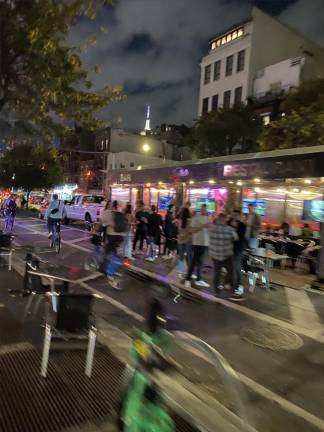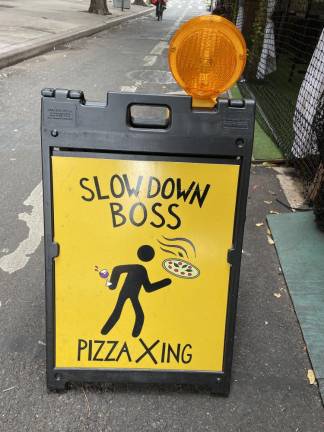Tensions have been rising ever since New York City restaurants began offering outdoor seating in June 2020. Bicyclists and restaurant workers are waging a war in the streets. The bike lane has become a battlefield awaiting spilled food — or worse. Recent legislative action making these roadside accommodations permanent confirms that there’s no end in sight.
Restaurateurs rejoice as the open restaurant initiative continues to keep them in business— over 11,000 restaurants and 100,000 jobs have been saved by the plan, according to the Permanent Open Restaurants presentation published by the The New York City Department of Transportation.
But cyclists find their daily commutes hindered by increased foot traffic in the bike lane. Those on wheels swerve, speed, and shout as they navigate customers and servers making their way to and from the outdoor dining sheds.
According to regular cyclist Alison Colby, continued outdoor dining provides no relief for those on bikes. She’s taken to riding in traffic instead of in the protected lanes, preferring to dodge cars instead of restaurant staffers and wandering diners. If the dining sheds stay in the street, she says, most cyclists will migrate into traffic lanes.
On February 24, the City Council voted to keep outdoor dining in place, though the DOT doesn’t necessarily envision dining sheds as part of the long term plan. There are plans to deconstruct the roadway streeteries built in a mid-pandemic haste, and focus on safer, sturdier accommodations.
But with the new permanent plans, even a complete eradication of roadway sheds would affect cyclists. Colby notes that sidewalk seating will still crowd her path. “If every restaurant that currently has a shed nabs up sidewalk space, there’s not going to be any place for pedestrians,” she says. “Then you get the issue of pedestrians being like, ‘Well, I’m not gonna walk there. I’m stepping into the bike lane.’”
“Bike Lane Nightmare Central”
Yet on Sunday mornings, Colby finds herself on the opposite side of the equation. She frequents an East Village culinary staple, Frank, and prefers to eat outside, even as case numbers drop. From her roadside table at the 23-year-old Italian favorite, Colby watches what she calls “bike lane nightmare central.” She believes it’s a disaster waiting to happen.
Frank is one of three dining establishments owned by longtime New York restaurateur Frank Prisinzano. He says that his restaurants have had the dining sheds up “since the day we were allowed to have them, literally.” While Supper’s outdoor space fits onto the sidewalk of East 2nd Street, Frank and Lil’ Frankie’s see speeding cyclists flying by the roadside structures all day long.
“It’s been problematic. A couple of my guys have gotten hit carrying pizzas,” Prisinzano says while standing outside his second restaurant, Lil’ Frankie’s. The accidents are predictable: food runners are hustling to keep up with booming business when a cyclist comes zooming through. The biker can’t slow down, and crashes into the waiter. “It’s happened twice here. And a couple times at Frank,” Prisinzano says. “We had a customer hit at Frank. She was okay, but, you know, it was scary.”
Outside of Lil’ Frankie’s, there’s a sign with flashing yellow lights that reads “SLOW DOWN BOSS, PIZZA XING” with an image of a moving figure holding a steaming pizza in one hand, and a wine glass threatening to spill in the other.
Live Music
Peruvian restaurant Baby Brasa is proud to display its outdoor dining shed, which the staff has dubbed “the cabana.” Bartender and waiter Nico Prentice is excited to welcome customers into the roadside area.
But the cabana doesn’t just hold diners. The open space hosts regular live music performances, and special events like bingo night and movie screenings, which are projected onto a large screen inside the patio area. A Sonos sound system plays music throughout the shed.
Prentice says that the musical entertainment will even catch the attention of some bikers, who then “stop by and take videos.”
While Baby Brasa’s business spiked due to the inviting outdoor space, the cabana does not necessarily follow the DOT’s guidelines for roadway dining. The DOT’s official webpage for Open Restaurants states, “Amplified sound is not allowed in either sidewalk or roadway dining setups.” The website only lists rules for seating, and does not address the use of the sheds as activity spaces.
Over on Eighth Avenue, bikers speed by warning signs outside a sports bar in Chelsea. Joe Arongino, co-owner of Shaffer’s bar and restaurant, asserts that everyone occupying his roadway structure takes heed of reckless cyclists.
“We’re constantly moving through the floor all the time saying, ‘Hey guys, watch the bike lane, watch the bike lane,’” he explains. “It’s kind of the same as ‘Do you have your vax cards?’ It becomes another natural thing in the industry that you do.”
Shaffer’s business has thrived since the restaurant’s capacity soared from 74 to 150 available seats with the outdoor area. Without the pandemic-born expansions, Arongino says his business would be dead, as would many others.
“It’s just completely transformed the city for the good.” Italian restaurateur Prisinzano says of the outdoor dining revolution. “I mean, without it, we would not have done well. It was a real saving grace for everyone, so I think everyone just accepts the caveats.”
“Bike Lane!”
The DOT says that since the start, the open restaurant program has been “a lifeline” for restaurants, “not a goldmine.” But some cyclists believe steadfastly that it’s the latter. “It’s basically doubled capacity for restaurants, so they like it. And that brings tax money, so the government officials like it,” says John Gray, who works a day job on Wall Street and spends nights on his bike, delivering for UberEats.
Bicyclist Colby believes that restaurants are moving beyond their territory, claiming space that isn’t theirs. “They’re not entitled to free public land. They’re just not, I’m sorry,” she says. “I want them to survive. I want them to thrive. I want people to be employed. But they do not get a free pass on taking public land.”
Meanwhile, on the northwest corner of 81st and Amsterdam, during a warm Thursday night, bar-goers and servers at The Gin Mill cautiously look both ways and hurry across the bike lane like it’s Fifth Avenue. Coming from both directions, flashing lights affixed to bicycles flash to warn that they are coming. A waitress leaps across to help patrons, “Every single time I feel like I’m on an adrenaline rush. Like I’m on a rollercoaster!”
Two men passing by pause to check the score of the baseball game being broadcast from inside the shed. They step into the road. A cyclist swerves around them, shouting “Bike lane!” and looking over his shoulder. It’s a symphony of bike horns, expletives, and close calls. The potential for an accident looms over the green path, a tight race between high-speed bikers and any pedestrian’s momentary lapse in judgment.

